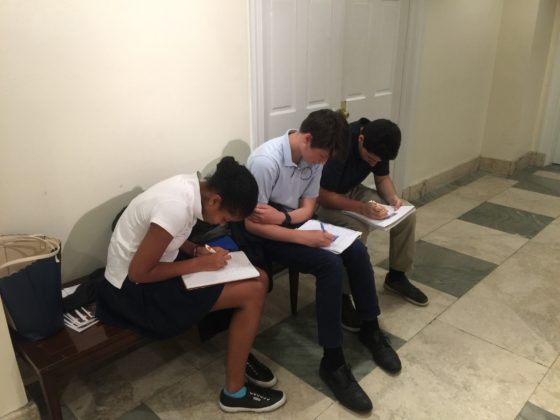- “La Parisienne” Goes to the Opera: Maria Callas as Priestess
- Over 40 US Policymakers Commemorate the 50th Dark Anniversary of the Turkish invasion in Cyprus at 39th Annual PSEKA Conference
- Remembering The Turkish Invasion of Cyprus and The Fight to Flee with Famagusta Native and Founder of Aktina FM Elena Maroulleti
- Marc Chagall And Greece: A Love Story
- $17 Million AHEPA Gift Will Open Doors For A Generation Of Students
The Soft Spot
By Panagiota Lilikaki*
The graduates think that I have a soft spot for them because they are the same age as the first class I taught Greek at the Greek Afternoon School at Saint Nicholas in 2012. They think that I have a soft spot for them because they are the first students that I taught English in 2015; because they bore with the pain that I called glory in class to polish their essays; because they were able to engage in classroom discussions regarding literary works at a higher level; because during the course of reading Steinbeck’s novella, The Pearl, they decided to hold a trial for Kino, the protagonist, on his defense; because they made up that additional homework that I sent at the last minute during a weekend via email; because they did not complain when I made them attend test-prep for three months for two hours every Tuesday right after school; because they selected an article from the “New York Times”, read it, modified it, so the younger audience of Nursery would be able to understand the content. And the toddlers loved when Nikiforos showed them a shirt soaked wet as a means to translate the article that he had read, or when Henriette narrated a fairy tale where she metamorphosed Zika into an evil queen, and George showed the youngsters an apple as a hook to deliver the latest news of the Apple Company and the customer who misused his i-phone to deliver “bad medicine to innocent children.”

Panagiota with some of her students at the Cathedral School
The graduates are right to think that I have a soft spot for them for all the reasons above, but they don’t know that in essence. I adore them because both my first students at Saint Nicholas and they have one characteristic in common: ethos. They cared enough to justify Steinbeck’s leading character – the author of the Lost Generation would have been impressed to find out that the students of the Generation Z cared deeply for his protagonist. They learned not to indulge in their successes and continued to work hard throughout the last two years. They were concerned about the appropriate way of delivering the news to school’s toddlers. Guy emailed me to find out how we talk to youngsters about doping after Sharapova’s confession on taking steroids. I will never forget the nursery students’ expression after Guy had asked, “Do you boys and girls believe that you should get a second chance after making a bad choice?”
I will always have a soft spot for them because while in class, there were just six students, but I had the support and trust of twelve additional people: their parents. I will always have a soft spot for the graduates for all the laughs and frustrations we shared. Let’s not forget Alex’s homemade chocolate chip cookies and sense of humor, George’s kindness, Henriette’s sense of justice, Guy’s discipline, Nikiforos’s critical thinking, and Marisa’s strong voice as a writer. All six of them just don’t know how great they are. I hope that Henriette will continue to be grateful for the chance she has in life, unlike her Oma – grandmother in German – “to live and learn freely.” For Marisa to continue to believe “in the power of the words that can shift the universe,” for Nikiforos to become the scientist who is going to find the means to “provide humanity with clean water,” for Alex to continue to have fun while inventing the new video game, for Guy to become the millionaire who is going to help the poor, for George to continue to view life with kindness. I bet he will be the best entrepreneur.

Panagiota with some of her students at the Cathedral School
On June 9, 2017, our last day in Greek class, all seven of us shared our feelings on a piece of paper. The lined sheet of paper circulated seven times, and our feelings in black and blue ink splashed sadness for leaving “a family environment,” happiness for the new beginnings, excitement for the new, and fear of the unknown. As I read the last line, “fear of the unknown,” I will borrow the lines of Caroline Paul and the article that I had sent to them to read at the last minute on Sunday, February 21, 2016, and remind them of her advice on how to handle fear: “I put my fear where it belonged, behind my feelings of focus, confidence, and courage.”
Last night, I revisited their past homework assignments and read their reflection papers after the visit to the Greek Consulate where they translated Yorgos Giotsa’s exhibition “Matters First” and the elements of fire and land through their creative and critical thinking:
Nikiforos Papadopoulos critiques,
The Union of Earth and Fire
A recurring concept in Giotsas’s art is Earth and Fire. The rustic appearance of the painting demonstrates the earthly elements of dirt, rocks, and resin, while some sections of the art appear to have been burnt using fire as a symbol of light, attempting to abolish the present evil of the world. In addition, the resin shines when you look at it, representing the power of Earth emanating from within. Texture is another vital component in Giotsa’s work of art. While there is the contrast of lighting, shading, and colors, along with the shading of dark colors, there are various textures as well, such as thick and thin layering. One can detect the rough and smooth surface of the art and the sweet smell of the resin and Earth, thus making it a true work of art.
Marisa Troncale reveals,
Two feathers,
A stick,
A chunk of gold,
And the wet sand.
The feeling of wet sand under your feet: curling and uncurling your toes as the water runs over wrinkled fingertips, only to be pulled back by the current to the never-ending ocean that lays before you. Open. Are you ready to swallow your whole into his vastness of open nothingness? Wait patiently.

Panagiota with some of her students at the Cathedral School
Henriette Keita observes:
A Wrap of Season and Soil
Gold crawls up the corners of the canvas, a defined line where the materials end and the gold begins. Warm, shining, and neutral colors unite. The last days of winter are behind me at last. The snow melts away in streams of water as the ice cracks, finally revealing the image: Dirt, twigs, leaves, and roots that have been hiding all winter are now moistened and ready to dry in the coming spring sunlight.
Alex Thanos explores:
The earth depicted in brown, the color of the dirt, and the three pieces of cement that are represented in the color of white symbolize the Holy Trinity and give hope to the spectator: In every evil lies the comfort of light and hope.
GM warns:
Do not Fear the Brown Mud.
Once upon a time, a seed emerged from the dirt. And the day that the seed grew enough, life evolved. And the people started to love each other. Do not fear the brown mud: the image of nature, life, and love.
And finally, GM brings it up:
Memories
The fire that brings life and adds texture and warmth, just like campfire wood when it is burning, reminds me of a planet drifting in the solar system, still lifeless yet full of memories.
After re-reading the graduates’ work, I can say that a feeling of hope for the future resides in my heart. The world will be a better place to be with the future citizens of the world who are continuing to believe in building character, working diligently, and always having fun while learning.
*Panagiota Lilikaki is an English/ Greek teacher at the Cathedral School in New York City
*The graduates got accepted to Loyola School, Fordham High School, Xavier High School, The Browning School, The Dominican Academy, United Nations International School, Baruch College Campus High School, Birch Wathen Lenox School, and Eleanor Roosevelt High School.











0 comments